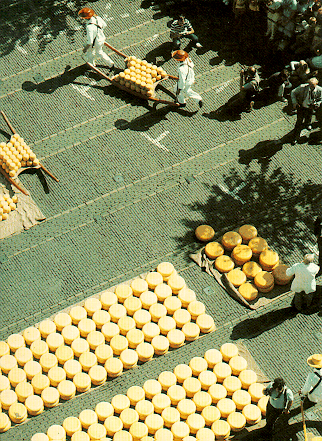 In his description of The Netherlands, published in 1567, the Italian
Guiccardini commented that Dutch Cheese and butter were worth as much as
all spices imported from Portugal, which were worth some million guilders
per annum. Cheese has been exported from The Netherlands since the midddle
ages. Cheese buyers are mentioned in the traditional statistics of the
fifteenth century.
In his description of The Netherlands, published in 1567, the Italian
Guiccardini commented that Dutch Cheese and butter were worth as much as
all spices imported from Portugal, which were worth some million guilders
per annum. Cheese has been exported from The Netherlands since the midddle
ages. Cheese buyers are mentioned in the traditional statistics of the
fifteenth century.
The Englishman Clifton Padiman rightly said that 'cheese is one step from milk
to eternity'. Milk deterionates very quickly, but if made into cheese it can
be taken great distances and sold. This trade centered around the cheese
markets. Towns with a Weigh House enjoyed special status. Haarlem was the
first town to have 'wheighing rights', granted by Floris V in 1266. Leiden
followed suit in 1303, then Oudewater in 1326 and Alkmaar in 1365. Although
it is not the oldest cheese market, Alkmaar is the most famous.
- Alkmaar
- For centuries Alkmaar has been the most important market for Edam
cheeses. The Weigh House is more than 400 years old. In 1492 Alkmaar lost
weighing rights because of a rebellion among its inhabitants, but in 1573,
after the 'victory of Alkmaar' the town got its title back from Willem of
Orange.
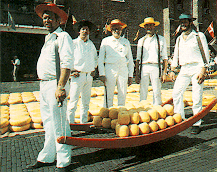 Cheese Bearers steal the show at Alkmaar >
Cheese Bearers steal the show at Alkmaar >
The cheese Bearers still wear their own colours and carry the cheese on
barrows to and from the weigh-house scales. Alkmaar's cheese market is open
from April to September, every Friday from 10.00- 12.00. For further
information contact the VVV (Tourist Office) in Alkmaar, +31 72-5114284.
- Gouda
-
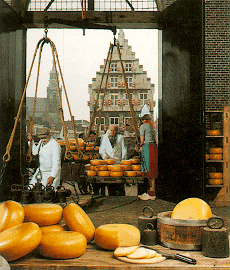 < The Weight House at Gouda, with the Town Hall in the background.
< The Weight House at Gouda, with the Town Hall in the background.
Gouda is not only the name of the most famous cheese in the world, it
is also the name of the commercial centre of the most important cheese region
in The Netherlands. The Weigh House dates back to 1669. A cheese market and
craft fair is held in the square, in which you can see the equally famous
Town Hall, every Thursday from early June to early September. Special
horse-drawn cheese carts carry nature's 'golden product'.
For further information contact
the VVV (Tourist Office) in Gouda +31 182-513666.
- Bodegraven and Woerden
-
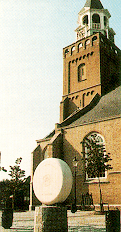 The Weight House at Gouda, with the Town Hall in the background. >
The Weight House at Gouda, with the Town Hall in the background. >
Cheese farmers sell their wares at the markets held at Bodegraven and
Woerden, both situated in the 'green heart' of The Netherlands. The cheese
market at Bodegraven dates back from 1882 and takes place every Tuesday
morning. A special autumn fair takes place on the second Tuesday of Septemer.
- Cattle Markets
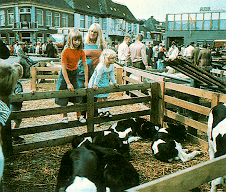 < A view of the cattle market at Schagen.
< A view of the cattle market at Schagen.
It is essential to the cattle farmer to be able to maintain good stock.
By breeding calves from his cuws (cows must calf before they can be milked),
he can be replenisch his herd. Bull calves are sold for fattening. As well as
selling his young stock the farmer also buys cattle. Buying and selling usualy
takes place at the various cattle markets which are held in The Netherlands.
Despite the advent of computers and high-tech communication, cattle markets
remain very traditional. Cattle are sold by a clap of hands. You can visit
Dutch cattle markets in Doetinchem, Groningen, 's-Hertogenbosch, Hoogeveen,
Leeuwarden, Leiden, Schagen, Purmerend, Sneek, Utrecht and Zwolle.
For further information contact the management of the local markets: Dutch
Cattle Market Group +31 58-2941500
 In his description of The Netherlands, published in 1567, the Italian
Guiccardini commented that Dutch Cheese and butter were worth as much as
all spices imported from Portugal, which were worth some million guilders
per annum. Cheese has been exported from The Netherlands since the midddle
ages. Cheese buyers are mentioned in the traditional statistics of the
fifteenth century.
In his description of The Netherlands, published in 1567, the Italian
Guiccardini commented that Dutch Cheese and butter were worth as much as
all spices imported from Portugal, which were worth some million guilders
per annum. Cheese has been exported from The Netherlands since the midddle
ages. Cheese buyers are mentioned in the traditional statistics of the
fifteenth century.

 Cheese Bearers steal the show at Alkmaar >
Cheese Bearers steal the show at Alkmaar >
 < The Weight House at Gouda, with the Town Hall in the background.
< The Weight House at Gouda, with the Town Hall in the background.
 The Weight House at Gouda, with the Town Hall in the background. >
The Weight House at Gouda, with the Town Hall in the background. >
 < A view of the cattle market at Schagen.
< A view of the cattle market at Schagen.